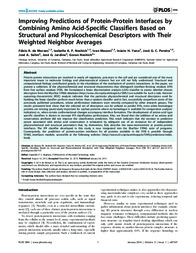Improving predictions of protein-protein interfaces by combining amino acid-specific classifiers based on structural and physicochemical descriptors with their weighted neighbor averages.
Improving predictions of protein-protein interfaces by combining amino acid-specific classifiers based on structural and physicochemical descriptors with their weighted neighbor averages.
Author(s): MORAES, F. R. de; NESHICH, I. A. P.; MAZONI, I.; YANO, I. H.; PEREIRA, J. G. C.; SALIM, J. A.; JARDINE, J. G.; NESHICH, G.
Summary: Protein-protein interactions are involved in nearly all regulatory processes in the cell and are considered one of the most important issues in molecular biology and pharmaceutical sciences but are still not fully understood. Structural and computational biology contributed greatly to the elucidation of the mechanism of protein interactions. In this paper, we present a collection of the physicochemical and structural characteristics that distinguish interface-forming residues (IFR) from free surface residues (FSR). We formulated a linear discriminative analysis (LDA) classifier to assess whether chosen descriptors from the BlueStar STING database (http://www.cbi.cnptia.embrapa.br/SMS/) are suitable for such a task. Receiver operating characteristic (ROC) analysis indicates that the particular physicochemical and structural descriptors used for building the linear classifier perform much better than a random classifier and in fact, successfully outperform some of the previously published procedures, whose performance indicators were recently compared by other research groups. The results presented here show that the selected set of descriptors can be utilized to predict IFRs, even when homologue proteins are missing (particularly important for orphan proteins where no homologue is available for comparative analysis/indication) or, when certain conformational changes accompany interface formation. The development of amino acid type specific classifiers is shown to increase IFR classification performance. Also, we found that the addition of an amino acid conservation attribute did not improve the classification prediction. This result indicates that the increase in predictive power associated with amino acid conservation is exhausted by adequate use of an extensive list of independent physicochemical and structural parameters that, by themselves, fully describe the nano-environment at protein-protein interfaces. The IFR classifier developed in this study is now integrated into the BlueStar STING suite of programs. Consequently, the prediction of protein-protein interfaces for all proteins available in the PDB is possible through STING_interfaces module, accessible at the following website: (http://www.cbi.cnptia.embrapa.br/SMS/predictions/index.html).
Publication year: 2014
Types of publication: Journal article
Keywords: Biologia, Biological sciences, Interações proteína-proteína, Proteins
Observation
Some of Embrapa's publications are published as ePub files. To read them, use or download one of the following free software options to your computer or mobile device. Android: Google Play Books; IOS: iBooks; Windows and Linux: Calibre.
Access other publications
Access the Agricultural Research Database (BDPA) to consult Embrapa's full library collection and records.
Visit Embrapa Bookstore to purchase books and other publications sold by Embrapa.

